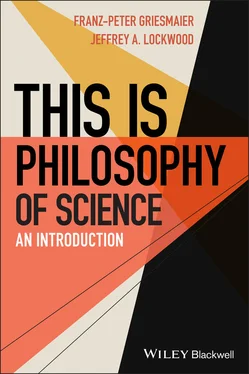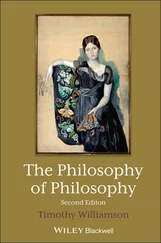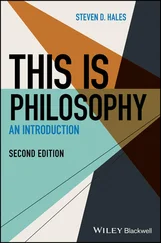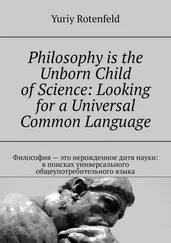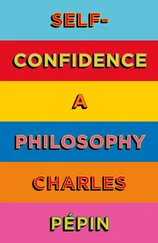Franz-Peter Griesmaier - This is Philosophy of Science
Здесь есть возможность читать онлайн «Franz-Peter Griesmaier - This is Philosophy of Science» — ознакомительный отрывок электронной книги совершенно бесплатно, а после прочтения отрывка купить полную версию. В некоторых случаях можно слушать аудио, скачать через торрент в формате fb2 и присутствует краткое содержание. Жанр: unrecognised, на английском языке. Описание произведения, (предисловие) а так же отзывы посетителей доступны на портале библиотеки ЛибКат.
- Название:This is Philosophy of Science
- Автор:
- Жанр:
- Год:неизвестен
- ISBN:нет данных
- Рейтинг книги:5 / 5. Голосов: 1
-
Избранное:Добавить в избранное
- Отзывы:
-
Ваша оценка:
- 100
- 1
- 2
- 3
- 4
- 5
This is Philosophy of Science: краткое содержание, описание и аннотация
Предлагаем к чтению аннотацию, описание, краткое содержание или предисловие (зависит от того, что написал сам автор книги «This is Philosophy of Science»). Если вы не нашли необходимую информацию о книге — напишите в комментариях, мы постараемся отыскать её.
This is Philosophy of Science
This Is Philosophy???
, This is Philosophy of Science: An Introduction
This is Philosophy of Science — читать онлайн ознакомительный отрывок
Ниже представлен текст книги, разбитый по страницам. Система сохранения места последней прочитанной страницы, позволяет с удобством читать онлайн бесплатно книгу «This is Philosophy of Science», без необходимости каждый раз заново искать на чём Вы остановились. Поставьте закладку, и сможете в любой момент перейти на страницу, на которой закончили чтение.
Интервал:
Закладка:
1.2 Reasoning from Evidence
Scientists most often make use of induction , or drawing conclusions from evidence. Generally speaking, induction is an inference from the observed to gain information about the unobserved (or unexamined) , and it takes three different forms: statistical inference, inductive generalization , and inference to the best explanation ( IBE) .
It is universally recognized that what these three forms of reasoning have in common is that they are defeasible. Beyond that, the terminology here is unfortunately not as widely agreed upon as it is with respect to deductive reasoning, but we can at least try to distinguish clearly between the three different forms of inductive reasoning just mentioned. Notice though that some textbooks in the sciences define inductive inferences as inferences from the particular to the general. This is misleading, because it covers only a tiny fraction of inductive inferences. We start with statistical inference.
1.2.1 Statistical Inference (SI)
The simplest example of an inductive inference is that of inferring something about an entire population from observing only some of its members. Recall the earlier example involving koalas: I inferred from having observed 20 of them munch exclusively on eucalyptus leaves that all members of the species Phascolarctos cinereus (that’s the koala’s scientific name) feed on eucalyptus leaves. Of course, such inferences are not restricted to biological populations. We might conclude that all igneous rocks are black, after we have seen many lava fields and observed that all of those were black. We can characterize the nature of statistical inferences in the following way:
A statistical inference is an inference from the observed frequency of a property in a sample to the claim that the same frequency holds for the population from which the sample was taken, within a certain margin of error.
Here is an example in explicit form:
| Premise 1: | The frequency of red marbles in a sample of 200 balls drawn from an urn was 49%. |
| Premise 2: | The urn contains exactly 1,000 marbles which are either red or black. |
| Conclusion: | The frequency of red balls in the urn is 50%, with a margin of error of ± 2%. |
Obviously, SI is an inference from the observed (the sample) to the unobserved (the population). Suppose you randomly picked up the first one hundred plants in a meadow and every one of them was a grass. You might well infer that every plant in the field was a grass. As we all know, beliefs (or hypotheses) based on SI can turn out false. Not all igneous rocks are black, and it’s unlikely that all plants in a meadow are grasses, although koalas seem to invariably eat eucalyptus. Often, this is due to sampling problems, which can never be fully eliminated (maybe all the tall plants that are easily accessed are grasses, but some small, ground-hugging plants are broad-leaved species). But even if the sampling doesn’t involve any bias, evidence from samples provides only defeasible reasons for beliefs about the relevant population, as the deviation of election results from predictions based on sampling (called polling) clearly demonstrates. There is much more to be said about SI, some of which you’ll find in later chapters.
1.2.2 Inductive Generalization (IG)
This form of inference is a bit more difficult to characterize to any great degree of precision. In fact, not even the name is widely agreed upon. Sometimes, IG is used to refer to what we call SI. Since nomenclature is a matter of convention, nothing really turns on it, as long as we are reasonably clear about the differences among the kinds of inferences. In order to begin developing a good understanding for what we decided to call IG, it’s best to start with an example.
Suppose you are interested in determining the functional relation between the period of a pendulum (how long it takes to pass through one cycle) and the length of its string. Dutifully, you plot changes in the dependent variable (the period) against variations in the independent variable (the length of the string). Unavoidably, you’ll get a general trend with a somewhat messy point distribution. If you were to precisely connect all the points, you’d end up with a jittery line. “Nature can’t be that crazy,” you mutter to yourself, as you begin accepting that some of the points might not fall exactly on the line describing the actual relationship. You know about air resistance, the variable elasticity of the string due to changes in ambient humidity levels, the imprecision of your starting and stopping the timing device, and other factors that really have nothing to do with the true relation between length and period (that’s why we call those factors “noise”). Thus, you decide to go for a nice, neat line – a section of a parabola, as it were. Then, you find the algebraic expression that generates that line. Finally, you make an inductive generalization and conclude that the period T of all pendula is related to the length l of their respective strings as follows: T =2π√l/g, where g is the gravitational acceleration. In fact, you are proud to have discovered the ideal pendulum law , which holds for all pendula with sufficiently small angular displacement. We will say more about the question of what a law of nature is in Chapter 12.
1.2.3 Inference to the Best Explanation (IBE)
This form of inference is exemplified by the story of caloric. The idea is that we observe some regularity and then postulate one or more mechanisms (or entities) that could be responsible for the observed regularity. If we can come up with just one, and it strikes us a plausible, we call it a day and accept it (this simplification will be corrected momentarily). If there is more than one, we look for the explanation which strikes us as best. To see what’s going on here, look at the following example, inspired by philosopher Elliott Sober. 2
Suppose you are sitting in your living room and suddenly hear strange noises coming from your attic – a quick succession of what sounds like little taps and then a rumbling noise. You consider two hypotheses: First, the noise is produced by gremlins from outer space that have landed on your roof and are now bowling in your attic. Call this hypothesis G. Second, the noise is produced by the neighbor’s cat, which got into your attic and is trying to catch mice, but keeps running into the books you have stacked up there. Call this hypothesis C. Clearly, C is better than G, although G is an explanation of sorts: If it were true, then the probability of hearing those noises would be quite high. However, the same is true of C, and since C is more plausible than G in light of all the other things you believe, C is clearly the better explanation. You then infer that the best explanation is the most probable one and thus accept C. You have inferred the best of the explanations under consideration; this is IBE.
Several things are worth commenting on. First, both G and C make the observation probable – both bowling gremlins and mouse-chasing cats could produce those noises you hear. Second, both C and G might be false. Maybe it’s neither cats nor gremlins, but it’s some neighborhood kids playing a practical joke. Third, and related to the last point, what hypothesis counts as the best is partially determined by which ones you can come up with. In other words, the best hypothesis from among those we thought of need not be a very good one, all things considered. Often, we miss an even better hypothesis, as we know from the history of science and discuss further in Chapter 12. In fact, the history of scientific progress is one of not only gathering more evidence but improving explanations such that was once the “best” is supplanted by something better.
Читать дальшеИнтервал:
Закладка:
Похожие книги на «This is Philosophy of Science»
Представляем Вашему вниманию похожие книги на «This is Philosophy of Science» списком для выбора. Мы отобрали схожую по названию и смыслу литературу в надежде предоставить читателям больше вариантов отыскать новые, интересные, ещё непрочитанные произведения.
Обсуждение, отзывы о книге «This is Philosophy of Science» и просто собственные мнения читателей. Оставьте ваши комментарии, напишите, что Вы думаете о произведении, его смысле или главных героях. Укажите что конкретно понравилось, а что нет, и почему Вы так считаете.
